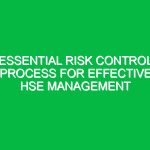Introduction
In the rapidly evolving world of industry and environmental management, implementing effective risk management techniques is paramount for ensuring health, safety, and environmental (HSE) sustainability. These techniques not only safeguard employees and the public but also protect the Environment from potential Hazards. Risk management involves identifying, assessing, and prioritizing risks followed by coordinated efforts to minimize, monitor, and control the probability of unfortunate events. This article delves into the essential risk management techniques applicable in the HSE domain, offering insights, methodologies, and real-life examples that will enhance your understanding and implementation of these practices.
Understanding Risk Management Techniques in HSE
To grasp the significance of risk management techniques in HSE, it’s vital to understand the elements involved. Risk management techniques encompass a broad range of strategies that aim to mitigate potential Hazards associated with health, safety, and environmental aspects of a business or Operation. These include methods for identifying risks, analyzing their potential impacts, and applying Control Measures to reduce the likelihood of incidents. The overarching goals are to protect workers, comply with Regulations, and promote environmental integrity.
Key Risk Management Techniques
1. Risk Identification
Risk identification is the foundation of any effective risk management strategy. It involves recognizing potential hazards that could negatively impact health, safety, and the environment. Techniques include:
- Workplace Inspections: Regular and systematic inspections of the workplace to identify potential hazards.
- Employee Surveys: Gathering input from employees regarding perceived risks and Safety concerns.
- Historical Data Analysis: Reviewing past incidents and accidents to uncover patterns and potential risks.
For example, a manufacturing facility may conduct a thorough inspection of machinery and equipment to identify wear and tear that could lead to malfunctions, emphasizing the importance of preventive Maintenance.
2. Risk Assessment
Once risks are identified, assessing their potential impact and likelihood is crucial. Risk assessment techniques include:
- Qualitative Risk Assessment: Using descriptive techniques to evaluate risks, often through brainstorming sessions or expert judgment.
- Quantitative Risk Assessment: Applying statistical methods to measure risks, often involving numerical data and modeling.
- SWOT Analysis: Analyzing strengths, weaknesses, opportunities, and threats in relation to identified risks.
By employing these techniques, organizations can prioritize risks based on their potential impact. For instance, a construction company might assess the risk of falls from heights as a critical issue due to its high likelihood and severe consequences.
3. Risk Control Measures
After assessing risks, it is essential to implement control measures. This can involve:
- Elimination: Removing the hazard completely from the work environment.
- Substitution: Replacing hazardous materials or processes with safer alternatives.
- Engineering Controls: Implementing physical changes to the workplace to reduce exposure to hazards, such as installing guardrails.
- Administrative Controls: Establishing policies and Procedures to minimize risks, such as mandatory Safety Training.
- PPE (Personal Protective Equipment): Providing workers with appropriate protective gear to minimize exposure to hazards.
A real-life example is the oil and gas industry, where engineering controls such as blowout preventers are essential for managing risks associated with drilling operations.
4. Monitoring and Review
The final step in effective risk management is ongoing monitoring and review of the risk management strategies. This is crucial to ensure that the implemented measures remain effective and relevant. Key components include:
- Regular Audits: Conducting systematic evaluations of risk management practices.
- Incident Reporting: Establishing a robust reporting system for incidents and near misses.
- Feedback Mechanisms: Encouraging input from employees regarding the effectiveness of risk controls.
For instance, a manufacturing facility may implement an incident reporting system that allows workers to report near misses, which can then be analyzed to improve safety protocols.
Benefits of Effective Risk Management Techniques
Implementing effective risk management techniques in the HSE context offers numerous Benefits, including:
- Enhanced Safety: Protecting employees and stakeholders from potential hazards.
- Regulatory Compliance: Meeting legal requirements and avoiding penalties.
- Cost Savings: Reducing costs associated with accidents, injuries, and environmental damage.
- Improved Reputation: Building trust with employees, customers, and the community.
These benefits underscore the importance of integrating risk management into the organizational culture, as seen in companies like DuPont, which is renowned for its commitment to HSE practices and has significantly reduced workplace incidents through effective risk management.
Best Practices in Risk Management Techniques
To maximize the effectiveness of risk management techniques in HSE, organizations should consider the following Best Practices:
- Engage Employees: Involve employees in the risk management process to gain valuable insights from their experiences.
- Continuous Training: Provide regular training to ensure employees are aware of risks and Safe Practices.
- Use Technology: Leverage technology, such as risk management software, for efficient tracking and reporting.
- Establish a Safety Culture: Foster an organizational culture that prioritizes safety and encourages proactive risk management.
For example, a construction company that regularly trains its workers on safety protocols sees a marked decrease in incidents, illustrating the effectiveness of continuous education.
Regulations and Standards Governing Risk Management Techniques
Understanding the regulatory landscape is essential for effective risk management in HSE. Various regulations and standards guide organizations in implementing risk management techniques. Key regulations include:
- OSHA (Occupational Safety and Health Administration): Mandates employers to provide a safe workplace and outlines specific safety standards.
- ISO 45001: An international standard for Occupational Health and safety management systems that provide a framework for risk management.
- EPA (Environmental Protection Agency) Regulations: Set standards for environmental protection, impacting how organizations manage environmental risks.
Compliance with these regulations not only minimizes legal risks but also enhances organizational credibility and stakeholder trust.
Conclusion
In conclusion, the importance of effective risk management techniques in promoting health, safety, and environmental Sustainability cannot be overstated. By employing comprehensive strategies such as risk identification, assessment, control measures, and ongoing monitoring, organizations can significantly reduce risks associated with their operations. The integration of these techniques ensures not only compliance with regulations but also fosters a culture of safety and responsibility. As industries evolve, ongoing commitment to improving risk management practices will be crucial in addressing emerging challenges. Organizations should continuously strive to enhance their HSE practices, ultimately contributing to a safer and more sustainable world for all.


